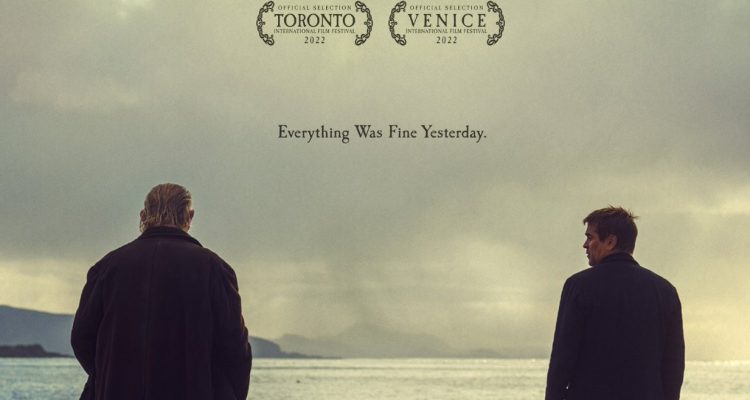Having won an Oscar for his 2004 short film “Six Shooter” (2004), Martin McDonagh has long been on the Academy’s radar. In 2008, he released his dark comedy “In Bruges,” which saw Colin Farrell and Brendan Gleeson work brilliantly off one another. It was a standout performance for Farrell, who had yet to showcase the range he would become known for later in his career.
After well over a decade, McDonagh has decided to reunite Farrell and Gleeson in his latest film, “The Banshees of Inisherin.” The film is set off the coast of mainland Ireland, shot in County Galway, with a gorgeous drone shot opening the film. Cinematographer Ben Davis does an incredible job building this bleak, weathered world that McDonagh envisions as 1920s Inisherin.
Colin Farrell plays a simple, dimwitted farmer named Pádraic whose life is without any real purpose or ambition (not that he minds). Pádraic spends his days with his best-animal-friend, a donkey, doing various chores and tending to his other livestock. Pádraic looks forward to the strike of the clock which signifies the “pub hour” for the inhabitants of the island.
Pádraic spends his evenings at the pub with his best-human-friend Colm (Brendan Gleeson)… or at least he used to do that. It seems that his violin-playing, misanthropic drinking buddy has decided to end their friendship in order to pursue a chance at having a legacy in the only manner he can think of… writing music.
Colm’s aim is to write one piece of music that might live on beyond his lifetime, like Mozart, who Colm references to Pádraic’s utter confusion. McDonagh frames the entire narrative around the sudden dissolution of the friendship and how the village gossips about it. The local Priest even tries to involve himself in the matter during one of Colm’s confessions.
Pádraic is perplexed, saddened, and angered over the sudden upheaval of his life, and seemingly won’t take no for an answer. Pádraic spends the rest of the film grappling with his loss and seeking solace in his very astute and highly educated sister, Siobhan (Kerry Condor), who is also struggling with her station in life on this desolate island.
Irish actress Kerry Condor captivates as Siobhan, delivering an electric performance that makes her a lock for a best supporting actress nomination. Prior to “Banshees,” Condor caught the eye of American audiences as Stacey Ehrmantraut on AMC’s “Better Call Saul,” opposite Jonathan Banks. Following “Banshees,” Condor could easily catch fire in the same manner as “Mission Impossible” breakout Rebecca Ferguson.
Siobhan, being the wisest character in the film, is also the only one who’s able to escape the island, taking a position as librarian on the mainland. The film’s least wise character, Dominic (Barry Keoghan), is also the most heartwarming by the end of the film.
Keoghan plays the character with several affectations which may seem exaggerated, but I found them completely earned and endearing as a challenged young man tries to navigate his impulses and find love. Dominic has no role model in his life, in fact, it’s even worse as he faces the wrath of his drunken, abusive policeman father (Gary Lydon).
Dominic feels sorry for Pádraic and tries to help him in his own fumbling way, giving Pádraic tidbits of pub conversations that he wouldn’t otherwise be privy to… this only makes matters worse as Pádraic confronts Colm and their relationship devolves into a literal bloody mess.
It’s this dark turn that sees Pádraic become someone else entirely, and when Pádraic reveals a cruel tactic to impede Colm’s musical dreams, Dominic is stunned and confronts him… shining a light on what Pádraic has done being the cruelest thing he’s ever heard.
Keoghan’s turn as Dominic deserves a supporting actor nod, and he’s at his best when he struggles to ask out Siobhan near a pond… it’s a painfully beautiful moment that redeems his more crass approach of asking her out earlier in the film.
The script is much more of a slow burn than “3 Billboards Outside Ebbing, Missouri.” This film lacks the gravitas of the circumstances of “3 Billboards,” which also benefited from an active protagonist spitting fire in the form of Frances McDormand’s Mildred Hayes.
“Banshees” contains arguably the lowest stakes of any film McDonagh could craft. Here, the writer/director gambles that the absurdity of the lead character’s plight will add even more humor to the film, and in many ways it does.
However, it can’t help but feel like a deflated follow up to his multiple Oscar winning masterpiece, “3 Billboards.” Once again, McDonagh crafts notable supporting turns in this film, but they don’t have nearly the arc given to Sam Rockwell and Woody Harrelson’s roles in “3 Billboards.”
“Banshees” aims to flip conventional stakes and narratives, becoming a meditation on one’s life… legacy… and ultimately the futility of it all. There’s a very ominous reference to banshees living on the island who have lost the will to shriek at people, and that profound comment resonates long after the credits role on this two hour anti-odyssey.
Letter Grade: B


